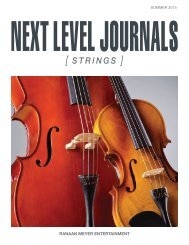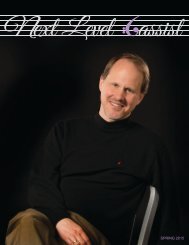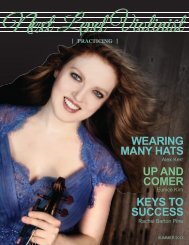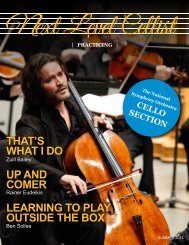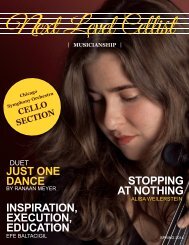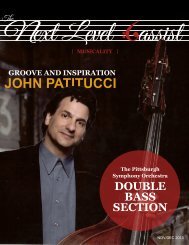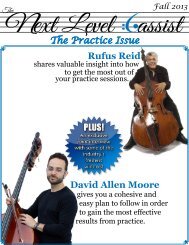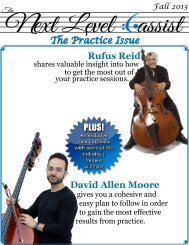Next Level Bassist Left Hand
Summer 2014 edition of Next Level Bassist. Left hand techniques and exercises by Nicholas Walker, Jordan Anderson, Paul Kowert. Section Spotlight on Cleveland Orchestra. Up and Comers Tim Dilenschneider and Jordan Morton
Summer 2014 edition of Next Level Bassist. Left hand techniques and exercises by Nicholas Walker, Jordan Anderson, Paul Kowert. Section Spotlight on Cleveland Orchestra. Up and Comers Tim Dilenschneider and Jordan Morton
You also want an ePaper? Increase the reach of your titles
YUMPU automatically turns print PDFs into web optimized ePapers that Google loves.
days a week I do my practice on a second bass, which has no dots. The<br />
interesting thing is that when I play that instrument, I still have the<br />
concept of the grid in my mind even though it isn’t there visually.<br />
How has this concept impacted your playing?<br />
Here’s and example that could be easily written down: Suppose you<br />
are playing a Baroque sonata in D major and you get to a cadence<br />
descending from the G harmonic g F # E D. Many traditional bass<br />
players would begin with the 3 rd finger harmonic and play 3 4 4 1 or<br />
3 4 1 1. Or maybe they’d play + 3 1 + with the thumb on the harmonics.<br />
Maybe someone would play 3 2 4 1 down the G string. What I would<br />
probably do now is play 2 1 + 2, ending on the D string. Why? That is<br />
D Major. The descending line fits in that D major hand position –<br />
harmonically it’s a 4 3 suspension resolving to D (F # trill E (short) D).<br />
That makes sense with the fingering, the phrase, the harmony, and the<br />
resonance of the bass. The previous fingering, 3 2 4 1, might be musically<br />
appropriate if the music was more passionately legato and an<br />
expressive inner hand slide from the F # to the E were in order.<br />
Let’s look at the default move that bass players often do: we play the<br />
G harmonic with thumb and play the other notes down the D string.<br />
This often sounds muddy because you have a half step across the<br />
two strings, with an F # sounding against the ringing G harmonic.<br />
Violinists try to avoid half steps in string crossings whenever possible<br />
because it just doesn’t sound good, especially with an open string. It’s<br />
comfortable to put your thumb on the harmonic at first, but with a<br />
little time, it’s just as comfortable<br />
to put the thumb on<br />
the E and B and build your<br />
hand setting down from<br />
the harmonic. With a little<br />
more time after that, it’s just<br />
as comfortable to build the hand<br />
setting down another half step and<br />
play it in D b Major, or any other key.<br />
There is also the component of<br />
strength and balance. The semichromatic<br />
(Petracchi) hand setting I<br />
use in the example above is a strong<br />
hand setting that uses only the top two strings and allows the player<br />
to play any of those four notes and be contextually grounded in the<br />
D major harmony. The brain and autonomic nervous system can put<br />
all of this together in a repeatable, contextualized construct: the 1 st<br />
finger F # will be a pure F # , in tune with the D harmonic under your<br />
second finger. Staying in this hand setting, the C # can be played on<br />
the D string, the E with the thumb on the G string; these build the C #<br />
diminished in D Major. If you then decide to move your hand position<br />
up or down, you can go from the dominant (V or vii) to the tonic<br />
(I), maintaining the harmonic grounding of the hand position all the<br />
while. The applications here are infinite in both written music, where<br />
we are striving to solidify intonation, and improvised music, where we<br />
are seeking expressive approaches to harmonic ideas.<br />
As both an improviser and as an interpreter of written music, it’s<br />
interesting to have a specific physiological context for each harmonic<br />
context I encounter. This approach has helped my ear to improve, it<br />
helped my intonation grow, and my accuracy is better. Of course I<br />
still have lots of room for improvement; it’s a lifelong process, but it’s<br />
no longer “put my thumb on this harmonic and try to play Bach’s 2 nd<br />
Suite!” And we’re not limited to 2 nd finger on the harmonic either (as<br />
in the above example). If you place your 1 st finger on the G harmonic,<br />
maintaining D Major, you now have access to the A on the G string<br />
with 3, and you have the triad in your hand frame. So when I improvise<br />
solos over changes in D, for example, I can access different instinctual<br />
musical language by setting my hand in different hand-settings: by<br />
setting my thumb on D,<br />
1 st finger on D, or 2 nd finger<br />
on D - each of these enable<br />
different ideas to emerge.<br />
Each hand setting lends<br />
itself to different sonic<br />
vocabularies, because it allows<br />
intuitive access to specific notes<br />
and chromatic approach tones,<br />
etc. I think this is really the wave<br />
of the future, at least for myself. It<br />
doesn’t matter whether I’m playing<br />
an accompaniment role, a solo<br />
role, or just thinking about the way a passage could sound beyond the<br />
limitations of the bass. Anyway, these some of the tools I’m using these<br />
days to expand my expressive capacity.<br />
Is there a technique book you recommend<br />
for this approach?<br />
From what I understand, Edgar doesn’t have a pedagogical method<br />
assembled for this, and from what I hear and have seen, he doesn’t<br />
really work any codified pedagogy per se with his students, except<br />
“make it sound great, and be dependable in performance”.<br />
David Allen Moore, who is one of the most comprehensively thoughtful<br />
and observant learners I’ve ever met, has observed Edgar closely,<br />
and also spoken to him about specific technical approaches. (By the<br />
way, Rex also studied in California with David and Paul Ellison).<br />
David and I have talked in the past about developing a flow chart for<br />
SUMMER 2014 NEXT LEVEL BASSIST 29




